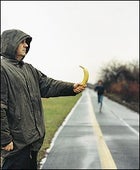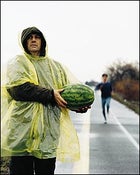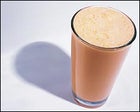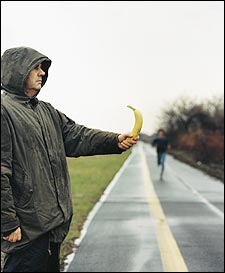IT TOOK USA Cycling-certified coach Adam Hodges Myerson more than a decade to figure out what had been preventing him from becoming a pro bike racer: his diet. Food, he discovered, should be used as both fuel and good medicine to speed recovery and keep you healthy. Currently heading up a coaching service called Cycle-Smart, based in Northampton, Massachusetts, Myerson began his amateur racing career by racking up impressive results in short order: victories at the 1990 Fitchburg Criterium in Fitchburg, Massachusetts, and later that year against the pros at the Marblehead Road Race. At his peak, in 1995, he finished eighth at the National Criterium Championships, riding full-time for Team HealthShare. But in those days, he knew little about nutrition beyond carbo-loading. “I was subsisting on energy bars and peanut butter and Minute Rice and ramen,” Myerson says. And each year, recurring colds and flu kept halting his training for weeks at a time. “If you miss a week of training four times a season,” he says, “you’re simply not going to achieve your potential.” In 1998, frustrated by a stalled racing career, Myerson quit and began researching a leaner diet to replace his high-calorie intake. He realized that for 11 years he’d been competing on a diet almost entirely bereft of fruits, vegetables, grains, and legumes in their natural, unrefined state. And it wasn’t until he added these missing ingredients that he learned just how pathetic his racing diet had been. “I felt noticeably better overall,” he says, “and then I started winning races again.”

Foods of Wonder
 Packed with good stuff: watermelon
Packed with good stuff: watermelonTHEY’RE CALLED whole foods, and you’re lost without them, friends. Problem is, few of you are paying attention. “Athletes are definitely eating more processed and packaged foods,” says Liz Applegate. As a nutrition consultant to U.S. Olympic teams and author of the Encyclopedia of Sports and Fitness Nutrition, she should know. In the flood of performance-nutrition products on the market now, what started out as fortified nutrition for use during competition has, in many cases, become a large part of an athlete’s daily diet. Athletes have become very good at managing their macronutrient intake (carbs, protein, and fat) with the help of a refined diet, but it’s often at the expense of micronutrients (vitamins, minerals, etc.). “Energy foods are wonderful,” says Applegate. “They give you exactly what you need when you’re exercising. They just don’t give you what you need to live on.” The word whole, as it relates to food, describes vittles that are as close to their natural state as possible. Lest you fear that opening your dietary door to whole foods means chasing raw brussels sprouts with a wheat-grass smoothie, allow us to set the record straight. There’s a far more palatable path to whole-foods enlightenment, and it’s lined with whole-grain bread and pasta, unprocessed meats (sorry, deli turkey doesn’t cut it), beans, and, most important, a smorgasbord’s worth of fruits and vegetables.
“Whole foods, and fruits and vegetables in particular, are packed with thousands of substances that protect them from the world they live in— things like ultraviolet light and nasty bacteria in the soil,” explains Applegate. “And since we live in the same world, it follows that those foods will supply us with the same protection.”
OK, that makes sense. Chief among these protective substances are phytochemicals, powerful antioxidants that counteract the cellular damage all exercise inflicts. It’s oxidative damage—the breaking down of muscle tissue by vicious atom clusters called “free radicals”—that makes you sore. Along with microtears in the muscle (which stimulate new muscle growth), they turn you into a groaning couch potato the day after a hard workout. (And before you pop an ibuprofen to ease that pain, see ““) This isn’t just about boosting your blood sugar with a bowl of pasta after you exercise. By bolstering your diet with foods rich in phytochemicals, you take care of your depleted energy needs and may even shorten the time it takes to recover from hard workouts. And as we all know by now, the faster and more completely you recover, the sooner you can return to peak form.
The Whole Plan
CAN CHEWING THROUGH a few energy bars really be that bad? No. During a competition or outing, they’re excellent fuel, but you don’t want to start mainlining them. Here’s something you probably didn’t expect to hear, though: Three or four servings of whole-foods fruits and vegetables each day aren’t enough. The USDA has long recommended that active males eat nine (that’s right, nine) servings of fruits and veggies daily to ward off, among other things, heart disease and even cancer. At present, only 2 percent of U.S. males meet this recommendation, according to a 2001 study commissioned by the Delaware-based Produce for Better Health Foundation.
Produce for Better Health recommends five daily doses of different-colored fruits and vegetables. The key here is variety. The human body benefits most from food synergy, which occurs only when different foods are eaten in combination.
Triathlon legend and exercise physiologist Dave Scott, a whole-foods advocate since 1979—when the refined food he was snarfing in preparation for the 1980 Ironman (try an eight-and-a-half-pound ice cream sundae) brought him to his knees—concurs: “Every day, there are more compounds identified in fruits and vegetables and grains. We don’t really know how they work synergistically, but we know they do.”
The beauty of whole foods is how easy it is to swallow those nine daily servings (see “,” for recipes to help). A banana sliced over oatmeal and a glass of orange juice: That’s two. Celery sticks and peanut butter for a midmorning snack, followed by tomato on your sandwich and a side salad at lunch, make five. At this rate you’ll hit double digits by the time you polish off a slice of apple pie after dinner (it counts, but no ice cream).
And what of Adam Hodges Myerson, our bike-racing whole-foods convert? He now eats oatmeal topped with raisins, peanut butter, and soy milk before his morning rides. For recovery, he mixes his own smoothies with soy milk, frozen blueberries, bananas, and strawberries. The result? Last season he didn’t suffer a single sick day and ended up winning three elite-level road races. In December he was offered his first professional cycling contract. Says Myerson, “I can’t wait for the season to start. I am so hungry for it.”
Power Foods

PRE-WORKOUT SMOOTHIE
(Makes four ten-ounce servings)
Packed with the sort of stuff that makes oxidants cower, this smoothie has staying power, courtesy of the protein-rich yogurt and low-glycemic fruit sugars.
INGREDIENTS
2 cups chopped or grated carrots
1 1/2 cups pineapple juice
1 cup fresh orange juice
3 tablespoons honey
4 ice cubes
1/2 cup vanilla nonfat yogurt
RECIPE
Dump everything in a blender and liquefy until smooth.
NUTRITIONAL VALUE (per serving)
Calories…………..180
Carbohydrates………43 g
Total fat………….0 g
Protein……………3 g
RECOVERY PASTA
(Makes four two-cup servings)
Most pasta dishes provide the carbs you need to restore glycogen levels and the protein demanded by overworked muscles. This one goes a step further by delivering three of the nine fruit-and-veggie doses you need daily.
INGREDIENTS
3 medium zucchinis, washed and ends removed
1 medium onion, peeled and chopped
2 cloves garlic, peeled and chopped
1 tablespoon olive oil
1 tablespoon dried basil leaf, crushed
1/2 teaspoon coarsely ground black pepper
2 cups prepared no-fat pasta sauce
1 cup chopped fresh tomatoes
8 ounces whole-wheat pasta
RECIPE
1. Quarter zucchini lengthwise and cut into half-inch pieces. Place zucchini, onion, garlic, and olive oil with seasonings in a large, deep skillet and sauté over medium heat until soft, stirring often.
2. Add prepared sauce, mix well, and simmer for five minutes. Stir in half-cup chopped tomato and heat thoroughly.
3. In a separate pot, cook pasta. Drain well and place in a large serving bowl. Add sauce and mix gently. Top with the reserved half-cup chopped tomatoes and chopped herbs. Serve hot.
NUTRITIONAL VALUE (per serving)
Calories …………314
Carbohydrates……..62 g
Total fat…………6 g
Protein…………..12 g


